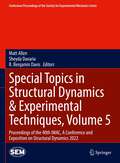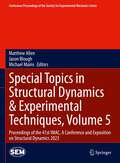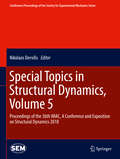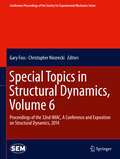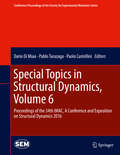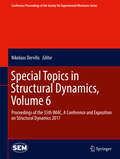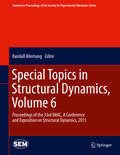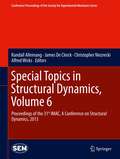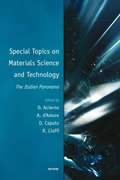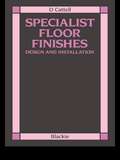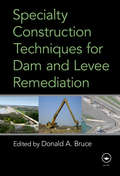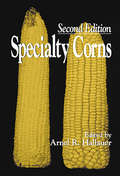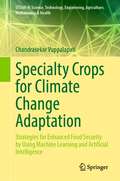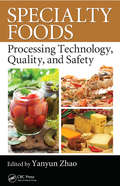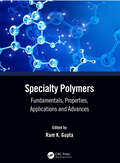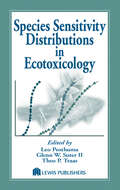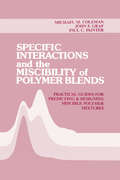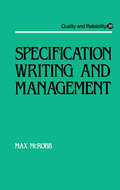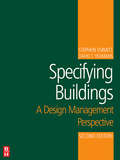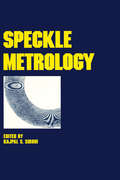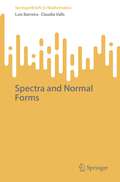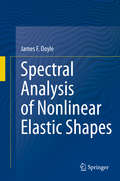- Table View
- List View
Special Topics in Structural Dynamics & Experimental Techniques, Volume 5: Proceedings of the 39th IMAC, A Conference and Exposition on Structural Dynamics 2021 (Conference Proceedings of the Society for Experimental Mechanics Series)
by David S. EppDynamics of Coupled Structures, Volume 5: Proceedings of the 39th IMAC, A Conference and Exposition on Structural Dynamics, 2021, the fourth volume of nine from the Conference brings together contributions to this important area of research and engineering. The collection presents early findings and case studies on fundamental and applied aspects of the Dynamics of Coupled Structures, including papers on:Methods for Dynamic Substructures Applications for Dynamic SubstructuresInterfaces & SubstructuringFrequency Based Substructuring Transfer Path Analysis
Special Topics in Structural Dynamics & Experimental Techniques, Volume 5: Proceedings of the 40th IMAC, A Conference and Exposition on Structural Dynamics 2022 (Conference Proceedings of the Society for Experimental Mechanics Series)
by Matt Allen Sheyda Davaria R. Benjamin DavisSpecial Topics in Structural Dynamics & Experimental Techniques, Volume 5: Proceedings of the 40th MAC, A Conference and Exposition on Structural Dynamics, 2022, the fifth volume of nine from the Conference brings together contributions to this important area of research and engineering. The collection presents early findings and case studies on fundamental and applied aspects of Structural Dynamics, including papers on:Analytical MethodsEmerging Technologies for Structural DynamicsEngineering ExtremesExperimental TechniquesFinite Element Techniques
Special Topics in Structural Dynamics & Experimental Techniques, Volume 5: Proceedings of the 41st IMAC, A Conference and Exposition on Structural Dynamics 2023 (Conference Proceedings of the Society for Experimental Mechanics Series)
by Matthew Allen Michael Mains Jason BloughSpecial Topics in Structural Dynamics & Experimental Techniques, Volume 5: Proceedings of the 41st IMAC, A Conference and Exposition on Structural Dynamics, 2023, the fifth volume of ten from the Conference brings together contributions to this important area of research and engineering. The collection presents early findings and case studies on fundamental and applied aspects of Structural Dynamics, including papers on:Active ControlAdditive ManufacturingExperimental TechniquesFinite Element TechniquesMultifunction StructuresRotating MachinerySystem Identification
Special Topics in Structural Dynamics, Volume 5: Proceedings Of The 36th Imac, A Conference And Exposition On Structural Dynamics 2018 (Conference Proceedings of the Society for Experimental Mechanics Series)
by Nikolaos DervilisSpecial Topics in Structural Dynamics, Volume 5: Proceedings of the 36th IMAC, A Conference and Exposition on Structural Dynamics, 2018, the fifth volume of nine from the Conference brings together contributions to this important area of research and engineering. The collection presents early findings and case studies on fundamental and applied aspects of Structural Dynamics, including papers on:Experimental MethodsAnalytical MethodsGeneral Dynamics & Modal AnalysisGeneral Dynamics & System IdentificationDamage Detection
Special Topics in Structural Dynamics, Volume 6
by Christopher Niezrecki Gary FossThis sixth volume of eight from the IMAC - XXXII Conference, brings together contributions to this important area of research and engineering. The collection presents early findings and case studies on fundamental and applied aspects of Structural Dynamics, including papers on: Linear Systems Substructure Modelling Adaptive Structures Experimental Techniques Analytical Methods Damage Detection Damping of Materials & Members Modal Parameter Identification Modal Testing Methods System Identification Active Control Modal Parameter Estimation Processing Modal Data
Special Topics in Structural Dynamics, Volume 6
by Dario Di Miao Pablo Tarazaga Paolo CastelliniSpecial Topics in Structural Dynamics, Volume 6. Proceedings of the 34th IMAC, A Conference and Exposition on Dynamics of Multiphysical Systems: From Active Materials to Vibroacoustics, 2016, the sixth volume of ten from the Conference brings together contributions to this important area of research and engineering. The collection presents early findings and case studies on fundamental and applied aspects of Structural Dynamics, including papers on: * Analytical Methods * Biological Systems * Dynamic Systems * Dynamics of Multi-Physical Systems * Structural Control * Simulation
Special Topics in Structural Dynamics, Volume 6
by Nikolaos DervilisSpecial Topics in Structural Dynamics, Volume 6: Proceedings of the 35th IMAC, A Conference and Exposition on Structural Dynamics, 2017, the sixth volume of ten from the Conference brings together contributions to this important area of research and engineering. The collection presents early findings and case studies on fundamental and applied aspects of Structural Dynamics, including papers on: Experimental Methods Analytical Methods General Dynamics & Modal Analysis General Dynamics & System Identification Damage Detection
Special Topics in Structural Dynamics, Volume 6
by Randall AllemangSpecial Topics in Structural Dynamics, Volume 6: Proceedings of the 33rd IMAC, A Conference and Exposition on Structural Dynamics, 2015, the sixth volume of ten from the Conference brings together contributions to this important area of research and engineering. The collection presents early findings and case studies on fundamental and applied aspects of Structural Dynamics, including papers on: Aircraft/Aerospace Active Control Analytical Methods System Identification Sensors and Instrumentation
Special Topics in Structural Dynamics, Volume 6: Proceedings of the 31st IMAC, A Conference on Structural Dynamics, 2013
by Alfred Wicks Christopher Niezrecki Randall Allemang James De ClerckSpecial Topics in Structural Dynamics, Volume 6: Proceedings of the 31st IMAC, A Conference and Exposition on Structural Dynamics, 2013, the sixth volume of seven from the Conference, brings together contributions to this important area of research and engineering. The collection presents early findings and case studies on fundamental and applied aspects of Structural Dynamics, including papers on: Teaching Experimental & Analytical Structural Dynamics Sensors & Instrumentation Aircraft/Aerospace Bio-Dynamics Sports Equipment Dynamics Advanced ODS & Stress Estimation Shock & Vibration Full-Field Optical Measurements & Image Analysis Structural Health Monitoring Operational Modal Analysis Wind Turbine Dynamics Rotating Machinery Finite Element Methods Energy Harvesting
Special Topics on Materials Science and Technology - The Italian Panorama
by D. Caputo D. Acierno A. D’Amore R. CioffiThis volume collects selected papers presented and discussed during the 9th National Conference organized by the Italian Association of Materials Engineering, AIMAT from 2008 at Piano di Sorrento (Napoli, Italy). It gives a valuable representation of highlights of the research and development activities running in 21 Italian universities and resear
Specialist Floor Finishes: Design and Installation
by D CattellFirst Published in 1989. Routledge is an imprint of Taylor & Francis, an informa company.
Specialty Construction Techniques for Dam and Levee Remediation
by Donald A. BruceDam and levee remediation has become more prevalent since the start of the twenty-first century. Given the vastness and complexity of the infrastructures involved, keeping up with maintenance needs is very difficult. Major surges in repair are usually triggered by nature‘s wake-up calls, such as hurricanes, floods, and earthquakes. The challenge ha
Specialty Corns
by Arnel R. HallauerCompletely revised and updated, the Second Edition of Specialty Corns includes everything in the first edition and more. Considered the standard in this field, significant changes have been made to keep all the information current and bring the references up-to-date. Two new chapters have been added to keep up with the latest trends: Blue Corn and
Specialty Crops for Climate Change Adaptation: Strategies for Enhanced Food Security by Using Machine Learning and Artificial Intelligence (STEAM-H: Science, Technology, Engineering, Agriculture, Mathematics & Health)
by Chandrasekar VuppalapatiSpecialty crops are defined as fruits and vegetables, tree nuts, dried fruits, horticulture, and nursery crops including floriculture. The value of specialty crop production in the United States accounted for 18.44 % of the $433.569 billion in agriculture cash receipts collected in 2021. In 2020, that ratio was 21.47% of the $363.464 billion. Specialty crops are gaining increasing attention across nation as demonstrated in the 2018 farm bill (Agricultural Act of the 2018 Farm Bill (P.L. 115-334)) with the increased number of provisions addressing specialty crop issues, reflecting their growing role in the global economy. The cultivation of Specialty crops, nevertheless, has its own challenges. Specialty crops are generally more sensitive to climatic stressors and require more comprehensive management compared to traditional row crops. Specialty crops face significant financial risks threatening US$1.6 Trillion global market due to their higher water demand. The mission of the book is to prepare current and future software engineering teams, agriculture students, economists, macroeconomists with the skills and tools to fully utilize advanced data science, artificial intelligence, climate patterns, and economic models to develop software capabilities that help to achieve Specialty crops and economic sustainability, through improved productivity for years to come and ensure enough food for the future of the planet and generations to come!
Specialty Foods: Processing Technology, Quality, and Safety
by Yanyun ZhaoSpecialty foods are made from high quality ingredients and offer distinct features to targeted customers who pay a premium price for their perceived benefits. The rise in production and sale of these foods has increased concerns over product quality and safety. Specialty Foods: Processing Technology, Quality, and Safety explores how these foods dif
Specialty Polymers: Fundamentals, Properties, Applications and Advances
by Ram K. GuptaThis comprehensive volume provides current, state-of-the-art information on specialty polymers that can be used for many advanced applications. The book covers the fundamentals of specialty polymers, synthetic approaches, and chemistries to modify their properties to meet the requirements for special applications, along with current challenges and prospects. Chapters are written by global experts, making this a suitable textbook for students and a one-stop resource for researchers and industry professionals. Key Features: - Presents synthesis, characterization, and applications of specialty polymers for advanced applications. - Provides fundamentals and requirements for polymers to be used in many advanced and emerging areas. - Details novel methods and advanced technologies used in polymer industries. - Covers the state-of-the-art progress on specialty polymers for a range of advanced applications.
Species Sensitivity Distributions in Ecotoxicology
by Glenn W. Suter II Leo Posthuma Theo P. TraasIn spite of the growing importance of Species Sensitivity Distribution models (SSDs) in ecological risk assessments, the conceptual basis, strengths, and weaknesses of using them have not been comprehensively reviewed. This book fills that need. Written by a panel of international experts, Species Sensitivity Distributions in Ecotoxicology reviews
Specific Interactions and the Miscibility of Polymer Blends
by John F. Graf Michael M. Coleman Paul C. PainterThis book with software provides powerful tools for the analysis, prediction and creation of new polymer blends, an area of significant commercial potential. The R&D approaches and methods described in the book have attracted the interest of polymer R&D leaders in industry, and have been put into use in several major chemical companies. The companion set of computer programs speeds and facilitates work in this area. FROM THE AUTHORS' PREFACE:During the 1980's a steadily increasing number of compatible systems [polymer blends] have been reported. We believe that miscible mixtures will prove to be fairly common and the purpose of this book is to explore the circumstances in which single phase materials can be obtained. We will also describe a model for the phase behavior of these mixtures which we believe to have a predictive value, or be used as a practical guide to polymer miscibility. Our approach is based on the use of association models which have until recently been largely ignored in treating hydrogen bonding in polymer mixtures. They have most frequently been applied to mixtures of alcohols with simple hydrocarbons, where the equilibrium constants used to describe association have most frequently been determined by a fit to thermodynamic data (e.g., vapor pressures, heat of mixing). In our work we have sought to, first, adapt this approach to a description of the phase behavior of polymer mixtures; second, develop spectroscopic methods that provide an independent measurement of the equilibrium constants. Our purpose in this book is to explore and describe this approach and illustrate its broad utility. We address two overlapping yet different audiences. One would be primarily interested in the broad nature of this approach and the practical applications of a simple model. The second would be more interested in the derivations of the equations and some of the fundamental aspects of the spectroscopy of these systems. Accor
Specification Writing and Management
by Max McrobbThis book deals with the fundamentals of specification writing and management. It is useful for anyone concerned with the preparation of standards in a world that is shrinking due to improvement in communication and where many specifications have to hold clarity when translated into other languages.
Specifying Buildings: A Design Management Perspective
by Stephen Emmitt David T YeomansSelecting the best materials, techniques and systems for each project and then specifying them correctly to meet all the requirements of quality, time, value, constructability, maintenance and durability is a fundamental aspect of architectural design. It also helps to determine the quality and environmental impact of the project. Specifying Buildings: A Design Management Perspective provides a unique insight into the entire specification process, from selecting materials and products to writing the specification, dealing with changes and minimising risk. This new edition has been extensively revised and includes new case studies, research findings and reviews to illustrate how to translate design intent into building assembly. The book is structured to meet the needs of students on construction-related programmes such as architecture, engineering, surveying and construction management. It provides valuable insights and practical guidance, with end of chapter exercises helping students achieve a thorough understanding of the specification process
Specifying Minor Works
by Patrick ReddinEfficient maintenance of a property requires a reliable assessment for defects or inadequacies and a systematic method for dealing with them. This book provides the information you’ll need for both. Throughout the specification process, all manner of issues face the surveyor, property manager or building engineer, from describing common defects to addressing energy efficiency and carbon emissions. In addition to these tasks the book also deals with: Prioritising works The practicalities of specification Building control Helping you navigate bureaucracy as well as tackling the practical challenges safely and effectively, this is a crucial guide for building engineers, surveyors, contractors and property managers.
Speckle Imaging Using Aperture Modulation (SpringerBriefs in Applied Sciences and Technology)
by Abdallah HamedThis book covers speckle image formation using a variety of modulated apertures. The central theme revolves around theoretical analyses, specifically the calculation of impulse responses or Point Spread Functions (PSFs) corresponding to these apertures. These calculations provide crucial insights into the resolution inherent in the resulting speckle images. The book begins with an examination of the recognition of the direction of new apertures from elongated speckle images, setting the stage for subsequent discussions. The theoretical analyses extend to diverse aperture designs, including Gaussian, graded-index, and modulated apertures. The book delves into the nuanced dynamics of contrast in speckle images, exploring the Voigt distribution and the effects of modulation on contrast. In addition to aperture-centric discussions, the book addresses the processing of the formed speckle images. The chapters impart a comprehensive understanding of speckle imaging, encompassing discrimination in microscopy using digital speckle images, the utilization of concentric hexagonal pupils, and the exploration of irregular apertures. The book culminates in a detailed exploration of speckle imaging in the context of an annular Hermite Gaussian laser beam. Overall, this book serves as a valuable resource for researchers and academics seeking a profound exploration of speckle image formation, modulation, and processing across a spectrum of apertures and theoretical frameworks.
Speckle Metrology
by R.S. SirohiThis practical reference offers state-of-the-art coverage of speckle metrology and its value as a measuring technique in industry.;Examing every important aspect of the field, Speckle Metrology: surveys the origin of speckle displacement and decorrelation; presents procedures for deformation analysis and shape measurement of rough objects; explains particle image velocimetry (PIV), the processing of PIV records, and the design requirements of PIV equipment; discusses the applications of white light speckle methods and the production of artificial speckles; describes the measurement of surface roughness with laser speckles and polychromatic speckles; illustrates semiautomatic and automatic methods for the analysis of Young's fringes; calculates the variation of Young's fringes with the change in the microrelief of the rough surface; and explicates hololenses for imaging and provides design details with aberration corrections for hololense systems.;With over 1500 literature citations, tables, figures and display equations, Speckle Metrology is a resource for students and professionals in the fields of optical, mechanical, electrical and electronics engineering; applied physics; and stress analysis.
Spectra and Normal Forms (SpringerBriefs in Mathematics)
by Claudia Valls Luís BarreiraThis book presents the reader with a streamlined exposition of the notions and results leading to the construction of normal forms and, ultimately, to the construction of smooth conjugacies for the perturbations of tempered exponential dichotomies. These are exponential dichotomies for which the exponential growth rates of the underlying linear dynamics never vanish. In other words, its Lyapunov exponents are all nonzero. The authors consider mostly difference equations, although they also briefly consider the case of differential equations. The content is self-contained and all proofs have been simplified or even rewritten on purpose for the book so that all is as streamlined as possible. Moreover, all chapters are supplemented by detailed notes discussing the origins of the notions and results as well as their proofs, together with the discussion of the proper context, also with references to precursor results and further developments. A useful chapter dependence chart is included in the Preface. The book is aimed at researchers and graduate students who wish to have a sufficiently broad view of the area, without the discussion of accessory material. It can also be used as a basis for graduate courses on spectra, normal forms, and smooth conjugacies.The main components of the exposition are tempered spectra, normal forms, and smooth conjugacies. The first two lie at the core of the theory and have an importance that undoubtedly surpasses the construction of conjugacies. Indeed, the theory is very rich and developed in various directions that are also of interest by themselves. This includes the study of dynamics with discrete and continuous time, of dynamics in finite and infinite-dimensional spaces, as well as of dynamics depending on a parameter. This led the authors to make an exposition not only of tempered spectra and subsequently of normal forms, but also briefly of some important developments in those other directions. Afterwards the discussion continues with the construction of stable and unstable invariant manifolds and, consequently, of smooth conjugacies, while using most of the former material.The notion of tempered spectrum is naturally adapted to the study of nonautonomous dynamics. The reason for this is that any autonomous linear dynamics with a tempered exponential dichotomy has automatically a uniform exponential dichotomy. Most notably, the spectra defined in terms of tempered exponential dichotomies and uniform exponential dichotomies are distinct in general. More precisely, the tempered spectrum may be smaller, which causes that it may lead to less resonances and thus to simpler normal forms. Another important aspect is the need for Lyapunov norms in the study of exponentially decaying perturbations and in the study of parameter-dependent dynamics. Other characteristics are the need for a spectral gap to obtain the regularity of the normal forms on a parameter and the need for a careful control of the small exponential terms in the construction of invariant manifolds and of smooth conjugacies.
Spectral Analysis of Nonlinear Elastic Shapes
by James F. DoyleThis book concerns the elastic stability of thin-walled structures — one of the most challenging problems facing structural engineers because of its high degree of nonlinearity — and introduces the innovative approach of using spectral analysis of the shapes and the stiffness to gain insights into the nonlinear deformations. The methodology greatly facilitates correlating the shape changes with the stiffness changes. Professor Doyle also develops specific computer procedures that complement finite element methods so that the ideas and methods are applicable to general structural problems. Basic validity of the procedures is established using key archetypal problems from buckling/post-buckling of columns, arches, curved plates, and cylindrical shells, all worked out in significant detail. The book is ideal for a wide variety of structural engineers, particularly those in aerospace and civil fields. Researchers in computational mechanics also find a rich source of new ideas for post-processing data from nonlinear analyses.

